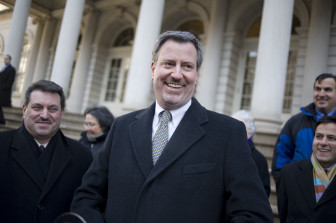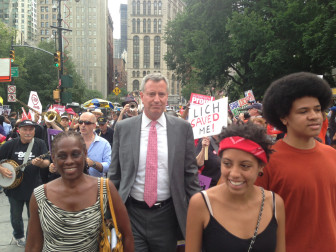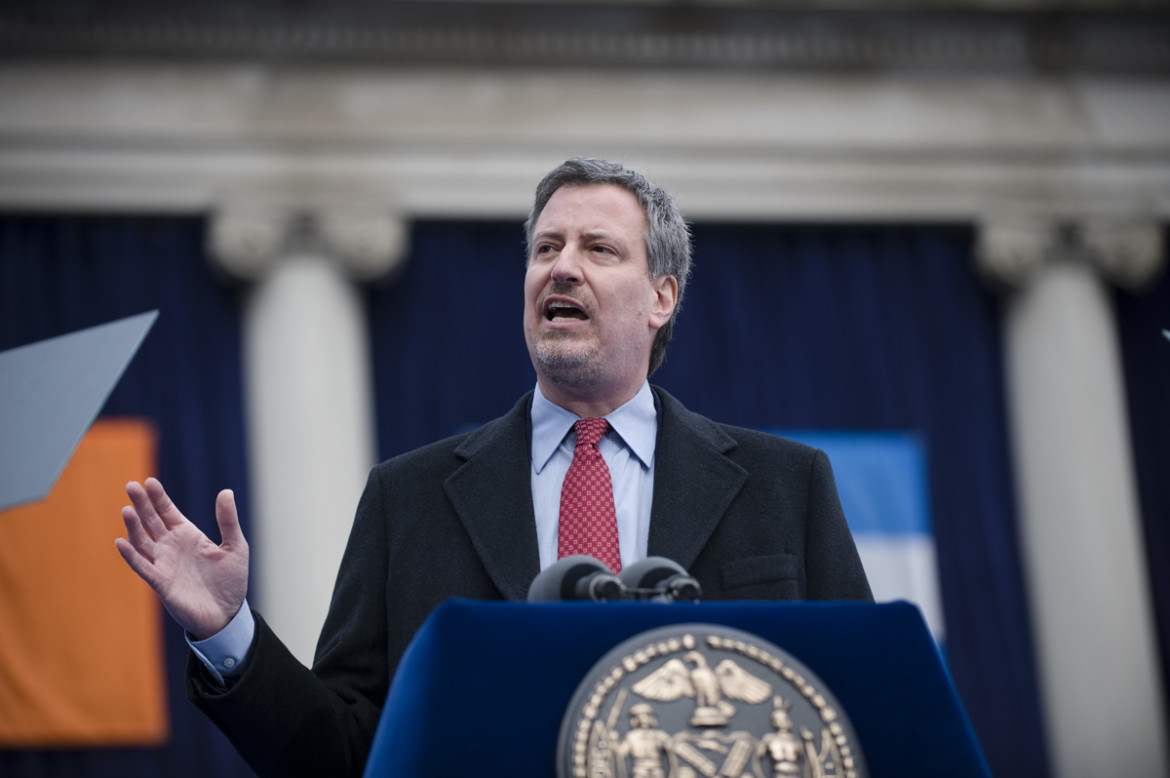
Bill de Blasio / Flickr
Public Advocate Bill de Blasio's Inauguration in 2010. (Photographer: William Alatriste)
NEW YORK -- The Democratic Party’s nominee for mayor of New York City, Bill de Blasio, didn’t have any speaking lines in his first television campaign advertisement, which debuted in August and helped push him to the top of the primary polls. Instead, the candidate’s son Dante, and his signature Afro, took center stage. The high school junior calmly explained that his father had the guts to “break from the Bloomberg years,” and was the only candidate who would “end an era of stop and frisk that unfairly targets people of color.”
Four days later, on Aug. 12, a federal judge ruled that the New York City Police Department’s stop and frisk program violated the constitutional rights of minorities. The next day, a Quinnipiac poll showed de Blasio atop the Democratic polls for the first time. He hasn’t hit a speed bump since, and the campaign ad, entitled “Dante,” has thrown into stark relief the power of a key juvenile justice issue to shape New York’s mayoral race. Last Thursday, a federal appeals court blocked the earlier ruling on stop and frisk, but it could be a moot point as de Blasio is widely expected to fundamentally reform the NYPD program.
With the election just a few days away, Blasio is hurtling toward an easy victory, riding a political pendulum that has swung back to the left after 20 years of Republican leadership in New York City. De Blasio has campaigned as an unabashed progressive, with withering criticism of stop and frisk at the core of his political branding.
 And as the former Brooklyn city councilman turned Public Advocate prepares to become the first Democrat since 1993 in Gracie Mansion, juvenile justice advocates have turned their attention to potential policy changes they’d like to see come to fruition after two decades under the leadership of Rudy Giuliani and Michael Bloomberg. With de Blasio’s lead in the polls so commanding, there was reluctance among juvenile justice experts to say anything specifically about the candidate or to contrast the Democrat’s potential policies with what the city has seen under Bloomberg. But make no mistake: reforms to stop and frisk, a change to New York state’s age of jurisdiction and school safety reforms are priorities the next four years in the world of juvenile justice.
And as the former Brooklyn city councilman turned Public Advocate prepares to become the first Democrat since 1993 in Gracie Mansion, juvenile justice advocates have turned their attention to potential policy changes they’d like to see come to fruition after two decades under the leadership of Rudy Giuliani and Michael Bloomberg. With de Blasio’s lead in the polls so commanding, there was reluctance among juvenile justice experts to say anything specifically about the candidate or to contrast the Democrat’s potential policies with what the city has seen under Bloomberg. But make no mistake: reforms to stop and frisk, a change to New York state’s age of jurisdiction and school safety reforms are priorities the next four years in the world of juvenile justice.
“Allowing another four years to pass without the age of jurisdiction being changed is hard to imagine,” said Annie Salsich, director of the Vera Institute’s Center on Youth Justice. “I’d be shocked. The issue doesn’t get heavy play, but it needs to be front and center in this term.”
New York and North Carolina are the only states that treat 16-year-olds as adults in the criminal justice system. It’s up to the state to change the law, but Salsich said the New York mayor can use his bully pulpit to push Albany towards a reform that is near the top of the list for juvenile justice advocates.
Even as juvenile justice advocates ticked off their list of key reforms for the next mayor, the conversations inevitably came back to stop and frisk, the issue that shaped the mayor’s race.

William Alatriste / Bill de Blasio / Flickr
In mid July, de Blasio was a fourth-place candidate struggling to garner support for a campaign he had pegged to inequality issues and a repudiation of Bloomberg’s policies. But the tide turned for the former head of the city’s erstwhile Department of Juvenile Justice, particularly with his telegenic son taking on a bigger role in the campaign.
After Anthony Weiner imploded, the New York Times ran an extensive story on the front page of its Aug. 5 edition about de Blasio’s push to address the city’s income inequity. Eight days later, de Blasio had broken from the crowded pack. He’ll be all but assured to cross the finish line Tuesday with a wide margin of victory over Republican Joe Lhota. In an election year in which Christine Quinn’s ties to Bloomberg, and also Police Commissioner Ray Kelly, became a liability, Lhota’s campaign has appeared to be a nonstarter.
De Blasio has said that he’ll replace Kelly, the architect of the stop and frisk policy that supporters credit with driving down crime and transforming New York into America’s safest big city. Critics, however, have long questioned the correlation. Stop and frisks dropped dramatically in recent months and crime has continued to tick steadily downward. New York hit a record low for murders in 2012 at 419 and is poised to come in lower again in 2013.
Although De Blasio seems poised to reform stop and frisk, he has not said explicitly that he’ll scrap the program. At a press conference this week, the New York Civil Liberties Union said that students living in neighborhoods where stop and frisk activity is high – East New York, Brownsville, Mott Haven, Jamaica and Harlem – are more likely to be suspended from school than students in other neighborhoods, linking stop and frisk to efforts to reform school discipline policies. NYCLU, citing recent research, said black and low-income students were disproportionately being arrested in NYC schools. The NYCLU called on the next mayor to “end the criminalization of school discipline.”
The NYCLU report comes on the heel of a Vera Institute study released in September that found stop and frisk was eroding confidence in the criminal justice system. Vera surveyed 500 18- to 25-year-olds in the neighborhoods mentioned above and found that residents who had been stopped and frisked by police were less likely to report crimes if they are later victimized, and that their likelihood of reporting a crime dropped significantly the more they were stopped. It was a troubling finding because members of this cohort are more likely to be victims of violent crimes and live in neighborhoods with low conviction rates, Vera said.
“This a group that law enforcement needs to reach out to and work with,” said Jennifer Fratello, director of research at Vera’s Center on Youth Justice. “Stop and Frisk as it’s practiced here seems to be eroding the kind of trust necessary to keep communities safe.”

Bill de Blasio / Flickr
Public Advocate Bill de Blasio and his wife Charline McCray and kids at a major rally to protest the closure of Long Island College Hospital and Interfaith Medical Center.
At the bottom of most juvenile justice policy is race -- a topic that is as much about human nature as it is about politics, an intractable and bedeviling problem in New York City even in 2013. Vera’s Salsich said race is the undercurrent running through juvenile justice issues, and needs to be a prominent feature of the upcoming policy discussions.
“That’s the cross-cutting issue,” she said. “In a city as diverse as New York City it has to be explicitly discussed.”
If De Blasio’s campaign rhetoric is to be believed, he’s attuned to the issues that juvenile justice advocates trumpeted as New Yorkers prepared to go to the polls. The Democrat’s popular television advertisements have focused on his unique, mixed-race family and there is hope in some quarters that he’ll pursue a bold, progressive vision for the city. Whether the realities of governing the unwieldy city in a shaky economy get in the way, and what that might mean for juvenile justice reforms, is another question.
